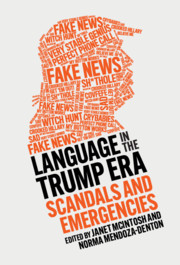Book contents
- Language in the Trump Era
- Language in the Trump Era
- Copyright page
- Dedication
- Contents
- Figures
- Tables
- Contributors
- Acknowledgments
- Note on Transcription Conventions
- Note on Ethnonyms and Phenotypic Descriptors
- Introduction: The Trump Era as a Linguistic Emergency
- Part I Dividing the American Public
- Part II Performance and Falsehood
- Part III The Interactive Making of the Trumpian World
- 9 Part III Introduction: Collusion: On Playing Along with the President
- 10 Banter, Male Bonding, and the Language of Donald Trump
- 11 On Social Routines and That Access Hollywood Bus
- 12 “Cocked and Loaded”: Trump and the Gendered Discourse of National Security
- 13 Evaluator in Chief
- 14 Fake Alignments
- Part IV Language, White Nationalism, and International Responses to Trump
- Index
- References
9 - Part III Introduction: Collusion: On Playing Along with the President
from Part III - The Interactive Making of the Trumpian World
Published online by Cambridge University Press: 18 September 2020
- Language in the Trump Era
- Language in the Trump Era
- Copyright page
- Dedication
- Contents
- Figures
- Tables
- Contributors
- Acknowledgments
- Note on Transcription Conventions
- Note on Ethnonyms and Phenotypic Descriptors
- Introduction: The Trump Era as a Linguistic Emergency
- Part I Dividing the American Public
- Part II Performance and Falsehood
- Part III The Interactive Making of the Trumpian World
- 9 Part III Introduction: Collusion: On Playing Along with the President
- 10 Banter, Male Bonding, and the Language of Donald Trump
- 11 On Social Routines and That Access Hollywood Bus
- 12 “Cocked and Loaded”: Trump and the Gendered Discourse of National Security
- 13 Evaluator in Chief
- 14 Fake Alignments
- Part IV Language, White Nationalism, and International Responses to Trump
- Index
- References
Summary
This section introduction introduces the theoretical concept of “collusion” in language studies, with reference to James Comey’s testimonial of what it is like to be “caught in Trump’s web.” In spite of themselves, those interacting with Trump often find themselves playing along with their designated role when their turn arrives to make a verbal contribution. Scholars of language have referred to dynamics like these as “collusion,” a kind of joint action that, in language studies, concerns the often-unwitting ways in which people coordinate and synchronize aspects of what they are up to in a speech event, playing into one another’s script while achieving a loose consensus about what is going on. Conversational collusion characterizes Trump’s congenial relationships with Fox News hosts, as well as the apparent lack of resistance when Trump enlists those around a conference table in performances of fealty to him. The chapter concludes by foreshadowing the work of this section’s chapters, concerning ritualistic routines of male in-group talk, and the ways in which collusive laughter and applause seem to ratify Trump’s authority.
Keywords
- Type
- Chapter
- Information
- Language in the Trump EraScandals and Emergencies, pp. 151 - 157Publisher: Cambridge University PressPrint publication year: 2020



